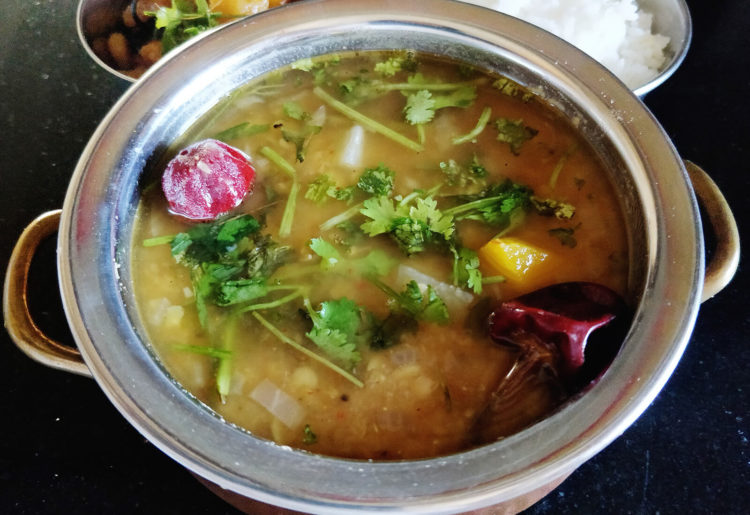Sambhar is synonymous with Tamilian cuisine. Most South Indians, especially those from Tamilnadu, just can’t get enough of sambhar, even though they have it in their daily diet. The tangy vegetable – lentil preparation, infused with sambhar powder in tamarind broth, is a must in every home, everyday. There are various stories regarding its origin. One interesting story goes like this.
Sambhar was accidentally made in the Thanjavur Maratha ruler’s Shahuji’s royal kitchen. While making Amti a Maharashtrian dish, they added tamarind, instead of kokum and red gram dal instead of moong dal/green gram dal. This was offered to the guest of the day, Sambaji, who relished it. Hence it was named sambhar.
Sambhar tastes different in various parts of India. The Sambhar made in Tamilnadu is spicier compared to the Karnataka version. In Tamilnadu too, the taste varies amongst different communities. The basic ingredients are the same but additions and omissions of certain ingredients give it a different taste.
The sambhar is generally cooked in kalchatti or stoneware to give a unique taste to it. Also gingelly oil or ghee is used in seasoning.
The use of gingelly oil gives a distinctive taste to the cuisine prepared in the region.
Recipe from Cook and See Part – 1.
Ingredients
- Tamarind (New) lighter in colour 15gms to 20 grams,
- Red chillies (either Bydagi or Guntur or gundu variety is used) 6,
- Green chillies 2 chopped into two
- Sambar powder 1/2 to 1 teaspoon,
- Rice flour 1/2 tsp (optional)
- Red gram dal ½ cup,
- Turmeric powder ¼ to ½ teaspoon,
- Fenugreek seeds ½ tsp
- Mustard 1 teaspoon
- Gingelly oil 3 teaspoon,
- Asafoetida ½ teaspoon or compounded asafoetida ¼ inch (pounded),
- Curry leaves few,
- Coriander leaves chopped fine few sprigs,
- Salt 1 teaspoon or to taste.
- Oil 3 tsp (gingelly / sesame),
- Vegetables : Any of the following can be used in combination or separately. Shallots / madras onions, Ladies finger, brinjal, drumstick, radish, pumpkin, ashgourd, chowchow, french beans, carrots, capsicum, cluster beans, chopped medium size or cubed. Peel the onions, chowchow if used — half cup (chopped medium size )
Method
- Soak the tamarind in 1 cup water for 10 to 15 minutes.
- Extract juice and by squeezing the tamarind by hand and removing maximum extract.
- Keep aside the juice for use.
- Cook the dal in pressure cooker to soft, adding turmeric powder. Mash it well when done.
- In a deep pan, add oil, add mustard, fenugreek seeds, red chillies (broken into two), chopped green chillies, asafoetida and curry leaves (torn into two).
- Add the vegetables you have chosen and saute for 2 minutes or so. Add tamarind juice and salt and cook in medium flame till vegetables are half done. Add sambhar powder and boil till the vegetables are well cooked and the raw smell of the tamarind goes.
- Add cooked, mashed dal to the sambar. Let it boil for 3 to 4 minutes.
- Add riceflour mixed in a teaspoon of water and boil for few seconds . Stir.
- Garnish with coriander leaves.
- Serve hot with rice .
Note
- If the sambhar is thick ,you can add more water to the sambhar.
- To get a thicker sambhar, add more cooked dal.
- if you need a spicier sambar, you can increase the sambar powder quantity by a teaspoon or more.
- Using more red chilies in the seasoning can increase the spiciness too.
- For reducing tanginess of the sambhar, reduce the quantity of tamarind.
- If you prefer sweeter sambhar, add a small lump of jaggery (10 to 15 grams) to the boiling sambar.
- While curry leaves are added to the sambar/rasam etc, they are torn into two and added.
- If the tamarind used is new, the sambhar gets a lighter colour, while the older tamarind gives a darker colour.
- Mostly rock salt or kaluppu is used in preparing the kuzhambu. Nowadays the usage of table salt is very prevalant, however the usage of rock salt is preferred.
